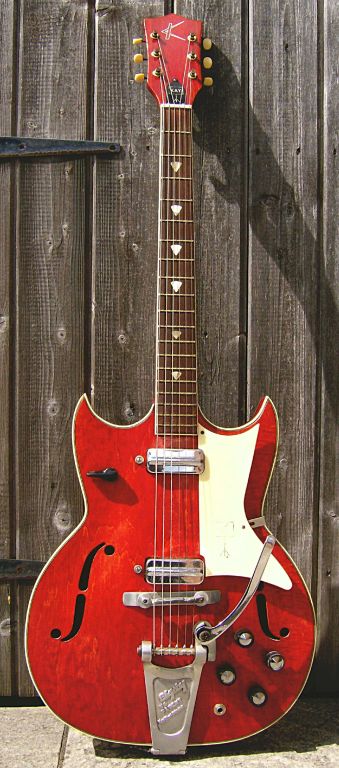

The UK's first glossy pop monthly was a magazine called Rave, launched in January 1964. Aimed at the newly affluent youth market, it promised “The frank look at today's pop world” and cost a serious half-a-crown. I'd occasionally get the opportunity to leaf through its pages courtesy of the more well-heeled girls in my final year at primary school. Among the cheesy pin-ups, jostling for attention with mysterious products like Pladay Excelsior corsetry and Stratnoid knitting pins, ran an ad for an electric guitar—the Red Devil, by Kay from the USA. To my 11-year-old sensibilities this was exciting stuff indeed, and I began to fantasise about owning such an instrument and creating suitably diabolical mischief with it.
The Kay company had been around since the 1930s, producing hundreds of thousands of mid-quality guitars, cellos and string basses from their West Walnut Street plant in Chicago. A small selection from their vast range began to appear in the UK in the early 1960s, including the all-maple K592 arch-top electric. Its chunky bolt-on neck featured a bound rosewood fingerboard with triangular pearl inlays and brass frets. Both top and back boasted a single veneer of choice curly maple, finished in a striking burgundy red, with plastic bindings, 4-ply on the top. Equipped with two chrome-plated single-coil pickups and a sturdy Bigsby B3 tremolo system, it certainly looked the business.
By my late teens I'd learned enough about guitars to know that Kay was not a name to aspire to, particularly as the brand had been sold, in the early 1970s, to Far Eastern manufacturers producing cheap beginners' guitars for Woolworths and various mail-order catalogues. But as my interest in vintage instruments grew, I recalled those early ads and kept a look out in the hope of actually seeing a Red Devil for real, but never did. Kay's European importers, Hohner, had done an extensive marketing job in the pop monthlies for well over a year, and must have sold a few, so where could they be?
Perhaps they didn't sell. At 65 guineas a pop, most aspiring rock'n'rollers would have chosen a second-hand Epiphone or Gretsch for the same outlay. Though better finished than the average Harmony or Hagstrom, the Red Devil is really only a second-stage instrument and doesn't deliver the sound its looks promise. Acoustically, the guitar is loud and warm sounding, though sustain is poor owing to the very shallow break angle of the strings across the bridge.
The pickups, which yield an anaemic 5.4KΩ resistance, do the guitar no favours at all and the bridge unit was broken when I got the guitar. I sourced a replacement on the Internet, and that was broken too! My natural curiosity sought a correction to the problem, and I observed that the windings were sealed into the covers with wax. By wrapping the pickup tightly in a plastic freezer bag and immersing it in boiling water for a few minutes, the wax melted and the magnet and coil dropped out, freeing the broken wrap—a messy business, but it worked. I then sent both pickups to Lindy Fralin, who re-wound them as a set. Fabulosa! The guitar sounds better now than it ever did.
What we have then is a beautiful piece of memorabilia, from a time when—as Keneally pointed out—to describe something as simply “OK for sound” was considered a credible marketing ploy! This particular devil may not have the best tunes, but it still puts on a pretty good show.